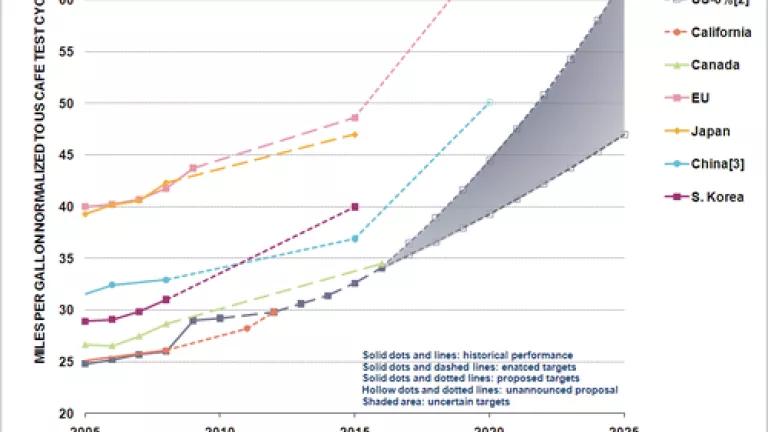
During his most recent weekly address, President Obama stated that the U.S. can “out-innovate and out-compete” the rest of the world by investing in and adopting clean energy. The President can realize this vision and grow good jobs in the U.S. automotive industry by setting standards that reach 60 miles per gallon (mpg) by 2025. Around the world, nations concerned about oil dependence and carbon pollution are ramping up efforts to make cars and trucks more efficient. If our standards fall behind, so will our technology leadership.
We already know high and volatile gas prices can affect the domestic car business. When prices spiked in 2008, car buyers shunned large, gas-guzzling SUVs that were the foundation of the Detroit 3’s profits. Buyers instead flocked to foreign models, like fuel-efficient cars and crossovers, built to go further on a gallon of gasoline. It’s not surprising that foreign automakers had a stable of vehicles to meet consumer needs. For years, companies based outside the U.S. have been building vehicles that meet more stringent efficiency and pollution standards.
The graph below, produced by the International Council on Clean Transportation, demonstrates that the U.S. has been a laggard on standards. Asian and European car makers have consistently been subject to stronger requirements at home and have been first movers in efficient technologies such as hybrids and advanced diesels.
The U.S. is making some progress but it could be short-lived. Between now and 2016, the first phase of the National Program for clean cars requires vehicles sold in the U.S. to reach 34 mpg. The Obama Administration, working with the State of California, is now considering a second phase of the program out to 2025 with annual improvements ranging from 3% to 6%.
According to analysis by the U.S. Department of Transportation, Environmental Protection Agency and California Air Resources Board, a weak 3% trajectory can be achieved primarily through modest improvements to conventional vehicles. Hybrid-electric vehicles would not need to expand from the current 3% of annual sales.
Only the 6% scenario, reaching about 60 mpg in 2025, will keep the U.S. on-pace with proposed efficiency increases in the EU and China. And there are at least two reasons why this is important for U.S. competitiveness in the global car market.
First, a weak U.S. requirement can be a barrier to the export of U.S.-made vehicles to other regions. That’s a big missed opportunity. Both the EU and China have higher annual sales than the U.S. and China’s market will grow steadily as its economy continues to rapidly expand. These foreign markets, however, demand more efficient vehicles than those currently required in the U.S. market. Strong U.S. standards can spur U.S. production of efficient technologies to sell abroad.
Second, only a strong standard like 60 mpg will catalyze growth in the nascent U.S. plug-in electric vehicle industry. The timing couldn’t be more important. The Chinese, in particular, are charging forward to win the global race in plug-in vehicles. Under their New Energy Vehicle Development Plan, the Chinese government is investing $15 billion in its auto industry with a focus on electric vehicles. China plans to put 500,000 plug-in electric vehicles on its roads by 2015, and while this is half the current U.S. target of a 1 million vehicles by 2015, the Chinese also have a goal of 5 million vehicles by 2020.
A 6% per year, 60 mpg standard is critical to the U.S. auto industry competiveness since it is the only level that creates the regulatory certainty necessary to ensure that the U.S. auto industry maintains and grows its plug-in electric vehicle investments.
A 60-miles-per-gallon standard is the clear choice for keeping the U.S. globally competitive in clean energy. It’s the clear choice for U.S. jobs. (It’s also the clear choice for dealing with high gas prices and our oil dependence.) The Obama Administration should seize the opportunity to out-compete the rest of the world by setting clean car standards that reach 60 miles per gallon by 2025.

